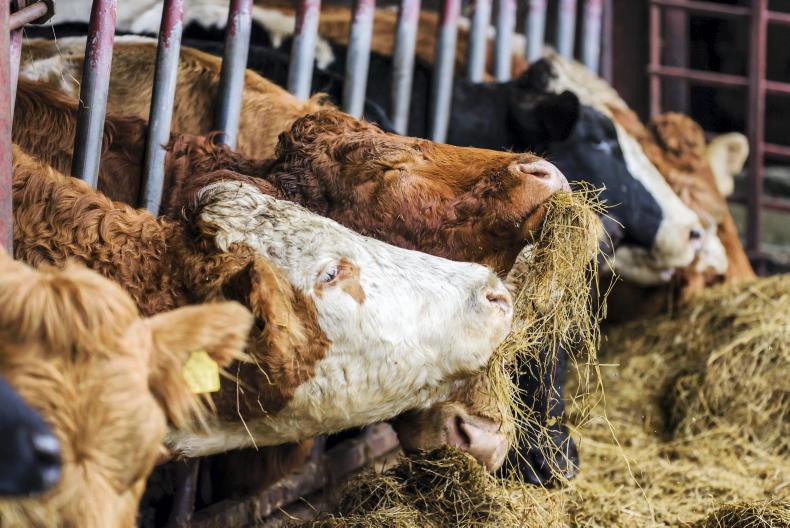This week’s launch of the Irish Farmers Journal spring series of webinars saw the topic of calving being discussed with Aidan Brennan, Declan Marren and Offaly vet Donal Lynch.
Topics on the night included pre-calving management, getting ready for a busy calving season, using the calving jack and taking care of the newborn calf.
Below, we have listed some of the questions and answers that came up on the night.
If I give my cows boluses at calving time, do I still need to feed dry cow minerals?
The answer is yes. Cows need a sufficient supply of minerals such as iodine, selenium and magnesium prior to calving to ensure healthy calves are born and also to ensure that no incidences of retained afterbirth occur.
While giving boluses to cows at calving time will help with breeding, it will be of no benefit to the cow calving.
Which is better: a cow's teat, a bottle teat or a stomach tube?
Getting a calf to suck its mother will always be best. It gives the calf more strength to get up and suck.
The next best thing is milking the cow and getting a calf to suck a teat, but this isn’t always practical where there are time constraints.
Cows need a sufficient supply of minerals such as iodine, selenium and magnesium prior to calving to ensure healthy calves are born
On Tullamore Farm, any calf that is assisted at calving is stomach-tubed with three litres of colostrum. All other calves are monitored to make sure they suck within the first two hours.
Is there any cure or solution for cryptospirosis scour problems?
With cryptospirosis, it’s probably more about prevention rather than cure.
Making sure the calf doesn’t come ingest cow faeces is probably the best route of prevention as that is how a calf contracts cryptospirosis.
Making sure cows are clean and dry before calving through adequate bedding is important.
If there is a severe outbreak on a farm, clipping around the udders and bellies of cows could be an option.
The only treatment available is a seven-day one and all other treatment is the same as any other scour.
Try not to let the calf get dehydrated and keep the calf topped up with fluids.
At what point do you call the vet at calving?
Donal Lynch said this was a difficult question to answer, as it could be different in relation to different cases.
Experience will generally tell the farmer at what point it’s time to call the vet.
Progress is key and if the cow hasn’t made progress, eg pushed out two feet or head two hours after the first water bag appeared, then you need to be investigating if there is a problem.
It’s better to ring the vet in time if you are unsure
When you handle the cow, if there is very little room around the calf or if you can’t get your hand across the top of the calf’s head, it could be a sign of problems.
Crossed legs could also be a sign of big shoulders. It’s better to ring the vet in time if you are unsure.
Is there a difference between licks, boluses and powder minerals?
All of the above have the minerals contained in the products and it’s down to what suits your system or farmer preference.
Boluses are probably best if you want to guarantee that a cow has the right amount of mineral ingested.
You need to read the manufacturer's label as to how long the bolus will last for and time the bolusing appropriately.
Powder minerals can be easily fed on top of silage, but you need to make sure that there is sufficient feed space to ensure all cows have access to them.
Licks can be used as well, but sometimes it’s difficult to know what cows are taking them in and what cows aren’t.
What can I do with a calf that I know hasn’t received enough colostrum within two hours of birth?
There is very little you can do if a calf hasn’t received enough colostrum within two hours of birth.
After two hours, the calf’s ability to absorb antibodies from the colostrum will reduce to very low levels two to six hours after birth.
The calf will gain its own level of immunity in the first few months of life, but it’s important that the calf wouldn’t be challenged in any way.
Making sure it is getting enough milk and under no other form of stress would be important in terms of keeping the calf as healthy as possible.
What’s the best way to heat colostrum?
It’s important when you are defrosting frozen colostrum that you don’t heat it too much, as this will denature the proteins and reduce the amount of immunity that it will deliver to the calf.
A water bath heated to 40°C is the ideal way to defrost colostrum.
While it will take a little longer, it will be worth it in terms of delivering the maximum amount of immunity to the calf.
Don’t put it in the microwave, as this will also reduce the antibodies in the colostrum.






 This is a subscriber-only article
This is a subscriber-only article











SHARING OPTIONS: